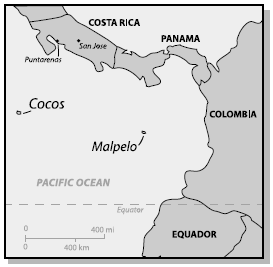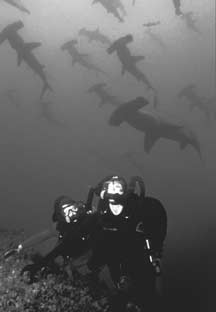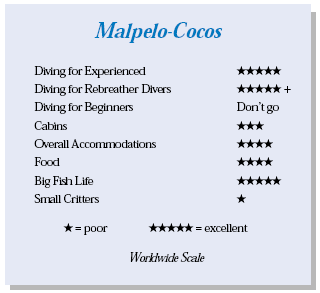Malpelo and Cocos Islands, East PacificContents of this Issue: Malpelo and Cocos Islands, East Pacific New Whale Shark Preserve in Belize Valet Diving for Your Next Half Century Shark Feeding Stops: $25 Million Suit for Lost Leg Editorial Office: Ben Davison Publisher and Editor Undercurrent 3020 Bridgeway, Suite 102 Sausalito, CA 94965 where the wild things are from the January, 2004 issue of Undercurrent
Dear Fellow Diver, It was my first dive on the seamount Alcyone, three miles off Cocos Island's south side. I was looking for schooling hammerheads as I descended the anchor line into a strong current. Upon reaching the bottom at 110 feet, I was greeted not by hammers but by a whale shark about 45 feet long, with a dozen large remoras on his flanks, back, tail, and around his massive mouth. As he cruised by, 30-pound albacore jacks suddenly attacked the remoras and devoured them right before my eyes. The remoras were at least three feet long, some larger, and the jacks gobbled them down like so much finger food. The whale shark continued his unhurried circles around the anchor line until the last remora was consumed, then he slowly descended out of sight. I'd visited Cocos Island, off Costa Rica in the Pacific Ocean, several times. It's always been an exciting experience that produced hammers and other great pelagic action and even a whale shark once. In June, I joined a charter on the 120-foot Sea Hunter for a triangular route to the remote and rarely visited Malpelo Island (off Colombia) and then on to Cocos before returning to Puntarenas on the Costa Rican mainland. It was arranged by Fathoms magazine and all the divers would be using rebreathers -- I've logged about 100 dives on the Draeger Dolphin semi-closed circuit unit. (As a woman traveling alone, I had some initial trepidation about joining a trip that might attract a certain "hairy knuckle" macho crowd of techies. As it turned out, those reservations proved unfounded.) We departed Puntarenas following a delay after Fathoms publisher Bret Gilliam and his partner Fred Garth couldn't land in San Jose due to bad weather. Another guest coming from England was delayed even later. Gilliam held the ship, though it cost the group a half-day of diving at Malpelo -- once the ship left port no guests could hook up with it. The vessel is spacious, but it's certainly a work boat. The cabins are live-aboard-compact with good storage. Some had queen beds as lower berths with a single bunk above while others had twin berths or upper/lower combinations. The largest cabin features a kingsize bed. Each has its own head with shower. The mattresses are a bit hard, and the blankets could be more substantial to combat the A/C, but I slept like a log. Six- to 10- foot seas and steady rain made for a dreary, rough crossing and half our 20-person group only appeared for meals during the 44-hour passage. Gilliam insisted on turning A/C down to the temperature of a walk-in refrigerator, saying it helped offset seasickness and the claustrophobia of cabins (which have only a tiny porthole for natural light). Following this, no one got sick and everyone kept their appetites. The Sea Hunter is comfortable. The main salon, which could easily accommodate our group, is separate from the dining area where seven booths seat everyone without crowding. The dive deck has ample locker storage for each diver and plenty of table space to work on rebreather preps. We arrived at Malpelo after two nights at sea. The storm had passed. We anchored at midday off the west end of the precipitous rocky cliffs that make Malpelo rise like a spire from the Pacific. It took 45 minutes for the crew to launch the two 26-foot pangas we used as dive launches. The aftermath of the storm left a 4-foot swell and a determined drizzle, but no one was complaining. After loading 10 divers in each of the two pangas, we were off to our first site, less than five minutes from the ship. Because of the group's experience and the fact that everyone was on
rebreathers, the Sea Hunter cut divers considerable slack. They permitted us 75-
minute dive times with no decompression or depth restrictions, as long as we
observed the maximum depth for the oxygen mixture. The captain, a taciturn Swede who rarely mingled with the guests, let the dive staff handle the social interaction. He and other crew members busied themselves supporting the daily dive operation while maintaining the ship, a spotless vessel without so much as a pinpoint of rust. Our first site was in the lee of the west cliffs. They told us to expect large schools of bigeye jacks and countless moray eels swimming over the rocky bottom. I rolled into 80-degree water with visibility greater than 100 feet. While drifting down I looked for symptoms of leakage or system failure, but my concentration was broken when a 6-foot moray swam between my legs. Then another swam through the double hose loop around my neck. I saw Miguel filming a baker's dozen of morays gracefully entwining themselves around him. Being groped like a high school prom date by my personal zoo of eels, I was both exhilarated and cautious, but I relaxed and carefully finned away to gain some breathing room. The craggy bottom was alive with swimming eels, many actively feeding. While getting used to the parade, I drifted along a steep wall in a refreshing current that pulled me around a corner. Immediately, a 40-foot female whale shark greeted me. For the next 15 minutes she made several passes, allowing me to swim right next to her. Back on the surface, I handed up my fins before using the boarding ladder to climb back into the panga. Those who preferred to lighten their load could remove their rebreathers and weight belts in the water, and the crew would lift them into the panga and secure them to their assigned places. After a quick lunch, we reboarded the pangas for our next dive to the north, where a large pod of dolphins hung for 20 minutes as we snorkeled with them. Afterward, divers scrambled to load new film and videotape, and it's a good thing. As soon as we entered the water, a 45-foot whale shark cruised by at a snail's pace, sweeping his massive tail in an arc almost 30 feet from side to side. Reaching the end of our group, he turned and repeated his "swim by" in deference, it seemed, to anyone who might have missed his first pass. This encounter lasted nearly 30 minutes, and I surfaced exhausted from sheer adrenaline. I found the large sun deck, up a flight of stairs behind the wheel house and crew cabins, a grand place to watch the sunsets with a glass of wine at the end of the day. Forward of the dining salon is a professional video editing suite and a PC station. E-mails and phone calls can be made from the wheelhouse via the satellite phone system. Our second day at Malpelo dawned with clear skies and calm seas. We dropped into a north flowing current to drift through upright pinnacles known as the Three Kings. I followed Mario down to 130 feet where a massive school of scalloped hammerheads swam lazily above the white sand bottom 20 feet below. At least 200 sharks averaging 10 feet in length politely ignored me. As the depth decreased approaching the Three Kings, the hammerheads ascended, completely surrounding me. Then Mario led the group up to 60 feet where the hammerheads parted ways with us when the current accelerated as we approached the narrow passage between pinnacles. Here, hundreds of schooling silky sharks finned through the channel, some an arm's length away. They have a nasty reputation for aggressive behavior, especially at Cocos where they've been known to cause divers to leave the water following threat displays. To be surrounded by hundreds of the 6- to 9-foot predators was indeed disquieting, but they seemed to accept us as just another critter in their ocean. When we reached the center of the Three Kings passage, the current conveniently petered out, and we were left to swim with this preposterous aggregation of silky sharks for nearly a half-hour. On a later dive at Monster Rock, we dispersed to explore the labyrinth of caves and overhangs that hosted more morays. After backing out of a nest of at least two dozen eels, I saw a whale shark making pretty good headway, so I swam over the top of the pinnacle to follow when, at 70 feet, a second, even larger whale shark swam up from the depths -- practically into Mario's arms. Meanwhile, the first whale shark, accompanied by four divers as escorts, arrived, and I captured both animals at once in the frame of my video camera. I stayed with the second animal, and it swam with me until I ran out of film nearly 10 minutes later. It was all a bit surreal. We made 11 dives around Malpelo in three and a half days and saw 13 whale sharks! Since we had missed
a half-day of diving at Malpelo, Gilliam let the group vote on
whether to depart for Cocos Island, 400
miles away. Incredibly, the vote was to
move on. It turned out to be the right call
as the weather immediately went sour after
our sunset departure. Meal service was buffet, with a variety of steaks, seafood, poultry, pork, and pasta. Nothing fancy, but plentiful. They cheerfully handled special dietary requests. Between-dive snacks were fresh tropical fruits and pastries hot from the oven. Local beer ($1.50) and a variety of soft drinks ($1) were offered on the honor system. Decent red and white wines were $10- $15 a bottle. Hard liquor is not sold, so most divers brought their own. Local rums are excellent and typically less than $7. Thirty some hours of steaming brought us into Cocos' protected Chatham Bay. The weather gods smiled on us, and the second storm subsided into calm seas and sparkling sunshine. My panga driver headed for the deep seamount called Alcyone. Mario set anchor directly on top of the seamount, and we followed him after his lift bag signal came up. Alcyone is a cleaning station for the hammerheads, and it's possible the whale sharks have developed their own symbiotic deal with the predator jacks (that's the remora slaughter I mentioned earlier). Alcyone typically sports 4-knot currents, which require a hand over hand descent on the anchor line. Then I could make my way across the pinnacle easily by finding shelter or "current shadows" behind the ledges or rock outcroppings. The most strenuous conditions were at Dos Amigos Pequeno, another rocky spire off Cocos' west end. It was not uncommon to be dropped in 6- to 8-foot swells with the immediate need to swiftly descend through as much as 20 feet of whitewater foam in a current that could sweep you off the site completely if you missed the sides of the steep rocky slope at 75 feet. (Three weeks before two divers were lost and died while diving the same site from the Okeanos Aggressor.) But with good briefings and sound advice on how to manage the entries and descents, as well as strict run times and ascent guidelines, none in our party had problems ... and the hammers were as thick as mosquitoes at a Cape Cod summer picnic. During several dives at Alcyone, descents to about 110 feet usually placed me smack in the middle of the hammerhead shark action. I'd find a rocky ledge to use as a current break and never move during the lengthy dives. Wave after wave of thousands of hammers, some pushing 14 feet or more, paraded a foot or so above me. I dove a bottle mix in the rebreathers of Nitrox 40 or 42 that was equivalent to breathing Nitrox 32 with open circuit gear. The 75-minute run times generally put me into short decompressions usually by the second dive. On the third dive, I frequently had 10-15 minutes of deco if the site had the most action below 100 feet. There were no problems doing decompression stops on the anchor line since the life support in the rebreathers gave us almost three hours of gas -- most open circuit divers could not do the exposures at all let alone the decompression stops.
On the east side of Manuelita Island, a small rocky key just off Chatham, I dropped in after sunset and was treated to hundreds of white tips frantically hunting in our light beams. I stayed 3 feet above the bottom to avoid the sharks' bumps and bites. During the next three days I saw mantas, eagle rays, tuna, sailfish, turtles that followed me like pets, and great schools of jack and Creole fish anywhere. Visibility ranged from 40 feet to 150 feet in some areas. No one skipped a single dive. Night dives were scheduled every other night, weather permitting. On our last day, Mario took us to a cleaning station he had named Silverado. This rocky ledge is perched in only 30 feet of water surrounded by a white sandy bottom. I could approach within a few feet of female silvertips nearly 10 feet long and probably weighing more than 400 pounds, who were being cleaned of parasites by barber fish. Nearby is a slightly deeper area where snake eels and red lipped batfish can be easily filmed. My group consisted of 16 men and four women, and I was assigned a double cabin with a female roommate. I was pleasantly surprised to find how well the group meshed. I've had a few less than perfect trips where women were either treated as oddities or sex objects, but this group respected and welcomed us into their fraternity. Most were veterans of multiple trips with Fathoms, and I fully expect that I'll be among them again. -- V.I.
|

I want to get all the stories! Tell me how I can become an Undercurrent Online Member and get online access to all the articles of Undercurrent as well as thousands of first hand reports on dive operations world-wide
| Home | Online Members Area | My Account |
Login
|
Join
|
| Travel Index |
Dive Resort & Liveaboard Reviews
|
Featured Reports
|
Recent
Issues
|
Back Issues
|
|
Dive Gear
Index
|
Health/Safety Index
|
Environment & Misc.
Index
|
Seasonal Planner
|
Blogs
|
Free Articles
|
Book Picks
|
News
|
|
Special Offers
|
RSS
|
FAQ
|
About Us
|
Contact Us
|
Links
|
3020 Bridgeway, Ste 102, Sausalito, Ca 94965
All rights reserved.

 Each dive was preceded by a detailed briefing outlining entry points,
underwater topography, and marine life. The
easy-going dive crew (Mario Arroyo of Costa
Rica, Nico Ghersnich of Italy, and Miguel
Sanchez of Spain) are all TDI instructors
with ratings for Nitrox, decompression procedures,
and rebreathers. Nitrox fills to
any oxygen percentage were provided. The
crew loaded and unloaded the rebreathers
from the pangas at the beginning and end of
each dive day.
Each dive was preceded by a detailed briefing outlining entry points,
underwater topography, and marine life. The
easy-going dive crew (Mario Arroyo of Costa
Rica, Nico Ghersnich of Italy, and Miguel
Sanchez of Spain) are all TDI instructors
with ratings for Nitrox, decompression procedures,
and rebreathers. Nitrox fills to
any oxygen percentage were provided. The
crew loaded and unloaded the rebreathers
from the pangas at the beginning and end of
each dive day. The captain had to
make a course change to ease the pitch and
roll so dinner plates and glasses didn't
become airborne. We enjoyed a good meal,
and most persons retreated to their cabins
or watched a movie in the main salon, where
there is a good selection of movies and dive
documentaries. Each evening featured exciting
video of the day's diving.
The captain had to
make a course change to ease the pitch and
roll so dinner plates and glasses didn't
become airborne. We enjoyed a good meal,
and most persons retreated to their cabins
or watched a movie in the main salon, where
there is a good selection of movies and dive
documentaries. Each evening featured exciting
video of the day's diving. The nearest chamber is in Panama
and no helicopter can reach Cocos and
no plane can land. Steaming time back
to the mainland takes nearly 40 hours,
so emergencies must be handled onsite.
Large volumes of oxygen are available
for 100% delivery via oral/nasal masks.
Gilliam had worked out a protocol with
the crew to conduct in-water recompression.
One diver accidentally missed
some decompression when she misread her
computer. Gilliam had her back in the
water within minutes to follow a twenty
minute omitted deco procedure. He then
put her on four hours of surface oxygen
and had her sit out diving for 24
hours. She was fine, and the crew
seems to have an excellent grasp for
the procedures.
The nearest chamber is in Panama
and no helicopter can reach Cocos and
no plane can land. Steaming time back
to the mainland takes nearly 40 hours,
so emergencies must be handled onsite.
Large volumes of oxygen are available
for 100% delivery via oral/nasal masks.
Gilliam had worked out a protocol with
the crew to conduct in-water recompression.
One diver accidentally missed
some decompression when she misread her
computer. Gilliam had her back in the
water within minutes to follow a twenty
minute omitted deco procedure. He then
put her on four hours of surface oxygen
and had her sit out diving for 24
hours. She was fine, and the crew
seems to have an excellent grasp for
the procedures.  Diver's Compass: These waters are no place to be if you fudged
your diving resume. ... This special Malpelo/Cocos itinerary is
only offered a few times each year. ... Fathoms charters the Sea
Hunter every year, usually for a month, and does back-to-back voyages.
... Book through
Diver's Compass: These waters are no place to be if you fudged
your diving resume. ... This special Malpelo/Cocos itinerary is
only offered a few times each year. ... Fathoms charters the Sea
Hunter every year, usually for a month, and does back-to-back voyages.
... Book through 